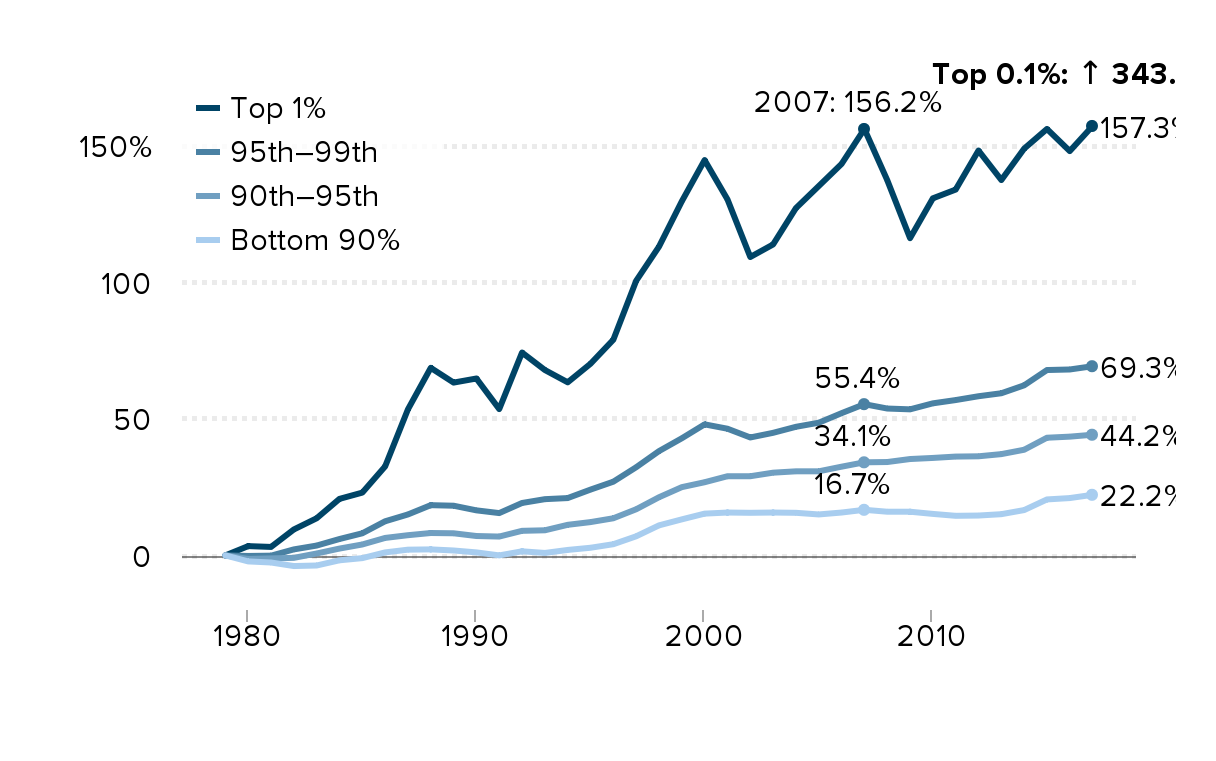Top 1.0 percent reaches highest wages ever—up 157 percent since 1979
Newly available wage data for 2017 show that annual wages grew far faster for the top 1.0 percent (3.7 percent) than for the bottom 90 percent (up only 1.0 percent). The top 0.1 percent saw the fastest growth, up 8.0 percent—far faster than any other wage group. This fast wage growth for the top 0.1 percent reflects the sharp 17.6 percent spike upwards in the compensation of the CEOs of large firms: executives comprise the largest group in both the top 1.0 and top 0.1 percent of earners. The fast wage growth of the top 1.0 percent in 2017 brought their wages to the highest level ever, $719,000, topping the wage levels reached before the Great Recession of $716,000 in 2007. The wages of the top 0.1 percent reached $2,757,000 in 2017, the second highest level ever, roughly only 4 percent below their wages in 2007.
These are the results of EPI’s updated series on wages by earning group, which is developed from published Social Security Administration data. These data, unlike the usual source of our wage analyses (the Current Population Survey) allow us to estimate wage trends for the top 1.0 and top 0.1 percent of earners, as well as those for the bottom 90 percent and other categories among the top 10 percent of earners. These data are not topcoded, meaning the underlying earnings reported are actual earnings and not “capped” for confidentiality.
Cumulative percent change in real annual wages, by wage group, 1979–2017
| Year | Bottom 90% | 90th–95th | 95th–99th | Top 1% |
|---|---|---|---|---|
| 1979 | 0.00% | 0.00% | 0.00% | 0.00% |
| 1980 | -2.20% | -1.30% | -0.20% | 3.40% |
| 1981 | -2.60% | -1.10% | -0.10% | 3.10% |
| 1982 | -3.90% | -0.90% | 2.20% | 9.50% |
| 1983 | -3.70% | 0.70% | 3.60% | 13.60% |
| 1984 | -1.80% | 2.50% | 6.00% | 20.70% |
| 1985 | -1.00% | 4.00% | 8.10% | 23.00% |
| 1986 | 1.10% | 6.40% | 12.50% | 32.60% |
| 1987 | 2.10% | 7.40% | 15.00% | 53.50% |
| 1988 | 2.20% | 8.20% | 18.40% | 68.70% |
| 1989 | 1.80% | 8.10% | 18.20% | 63.30% |
| 1990 | 1.10% | 7.10% | 16.50% | 64.80% |
| 1991 | 0.00% | 6.90% | 15.50% | 53.60% |
| 1992 | 1.50% | 9.00% | 19.20% | 74.30% |
| 1993 | 0.90% | 9.20% | 20.60% | 67.90% |
| 1994 | 2.00% | 11.20% | 21.00% | 63.40% |
| 1995 | 2.80% | 12.20% | 24.10% | 70.20% |
| 1996 | 4.10% | 13.60% | 27.00% | 79.00% |
| 1997 | 7.00% | 16.90% | 32.30% | 100.60% |
| 1998 | 11.00% | 21.30% | 38.20% | 113.10% |
| 1999 | 13.20% | 25.00% | 42.90% | 129.70% |
| 2000 | 15.30% | 26.80% | 48.00% | 144.80% |
| 2001 | 15.70% | 29.00% | 46.40% | 130.40% |
| 2002 | 15.60% | 29.00% | 43.20% | 109.30% |
| 2003 | 15.70% | 30.30% | 44.90% | 113.90% |
| 2004 | 15.60% | 30.80% | 47.10% | 127.20% |
| 2005 | 15.00% | 30.80% | 48.60% | 135.30% |
| 2006 | 15.70% | 32.50% | 52.10% | 143.40% |
| 2007 | 16.7% | 34.1% | 55.4% | 156.2% |
| 2008 | 16.00% | 34.20% | 53.80% | 137.50% |
| 2009 | 16.00% | 35.30% | 53.50% | 116.20% |
| 2010 | 15.20% | 35.70% | 55.70% | 130.80% |
| 2011 | 14.50% | 36.20% | 56.90% | 134.00% |
| 2012 | 14.60% | 36.30% | 58.30% | 148.30% |
| 2013 | 15.10% | 37.10% | 59.40% | 137.50% |
| 2014 | 16.60% | 38.70% | 62.30% | 149.00% |
| 2015 | 20.50% | 43.10% | 67.90% | 156.20% |
| 2016 | 21.00% | 43.50% | 68.10% | 148.10% |
| 2017 | 22.20% | 44.20% | 69.30% | 157.30% |

Source: EPI analysis of Kopczuk, Saez, and Song (2010, Table A3) and Social Security Administration wage statistics
As Figure A shows, the top 1.0 percent of earners now earn by 157.3 percent more than they did in 1979. Even more impressive is that those in the top 0.1 percent had more than double that wage growth, up 343.2 percent since 1979 (Table 1). In contrast, wages for the bottom 90 percent only grew 22.2 percent in that time. Since the Great Recession, the bottom 90 percent enjoyed very modest wage growth, with annual wages (i.e., reflecting growing annual hours as well as higher hourly wages) up just 5.4 percent over the eight years from 2009 to 2017. In contrast, the wages of the top 0.1 percent grew 29.8 percent from 2009 to 2017 (Table 1).
Wages fell furthest among the top 0.1 and 1.0 percent of earners during the financial crisis and, as noted above, the top 0.1 percent have not yet recovered their prior earnings (though they now have just had their second best year ever).
Change in annual wages, by wage group, 1979–2018
| Percent change | Percent change | ||||||||||
|---|---|---|---|---|---|---|---|---|---|---|---|
| Average annual wages (2017 dollars) | Long-term | Great Recession | |||||||||
| Wage group | 1979 | 2007 | 2009 | 2016 | 2017 | 1979–2007 | 1979–2017 | 2007–09 | 2009–17 | 2016–17 | 2007–17 |
| Bottom 90% | $29,608 | $34,542 | $34,332 | $35,838 | $36,182 | 16.7% | 22.2% | -0.6% | 5.4% | 1.0% | 4.7% |
| Top 90th to 99th | $96,843 | $140,739 | $140,373 | $151,575 | $152,476 | 45.3% | 57.4% | -0.3% | 8.6% | 0.6% | 8.3% |
| 90%–95% | $82,122 | $110,096 | $111,127 | $117,817 | $118,400 | 34.1% | 44.2% | 0.9% | 6.5% | 0.5% | 7.5% |
| 95%–99% | $115,245 | $179,043 | $176,932 | $193,773 | $195,070 | 55.4% | 69.3% | -1.2% | 10.3% | 0.7% | 9.0% |
| Upper 5% | $148,063 | $286,352 | $262,307 | $293,608 | $299,810 | 93.4% | 102.5% | -8.4% | 14.3% | 2.1% | 4.7% |
| Upper 1% | $279,336 | $715,586 | $603,810 | $692,948 | $718,766 | 156.2% | 157.3% | -15.6% | 19.0% | 3.7% | 0.4% |
| 99.0%–99.9% | $241,260 | $475,466 | $434,834 | $486,396 | $492,311 | 97.1% | 104.1% | -8.5% | 13.2% | 1.2% | 3.5% |
| 99.9%–100% | $622,018 | $2,876,667 | $2,124,597 | $2,551,917 | $2,756,865 | 362.5% | 343.2% | -26.1% | 29.8% | 8.0% | -4.2% |
| Average | $38,161 | $50,910 | $49,571 | $52,825 | $53,474 | 33.4% | 40.1% | -2.6% | 7.9% | 1.2% | 5.0% |
Source: EPI analysis of Kopczuk, Saez and Song (2010) and Social Security Administration wage statistics
These disparities in wage growth reflect a major change in the distribution of wages since 1979. The bottom 90 percent earned 69.8 percent of all earnings in 1979 but just 60.9 percent in 2017. In contrast the top 1.0 percent increased its share of earnings from 7.3 percent in 1979 to 13.4 percent in 2017, a near doubling. The growth of wages for the top 0.1 percent is the major dynamic driving the top 1.0 percent earnings as the top 0.1 percent more than tripled its earnings share from 1.6 percent in 1979 to 5.2 percent in 2017.
Change in wage groups' shares of total wages, 1979–2017
| Percentage point change | Percentage point change | ||||||||||
|---|---|---|---|---|---|---|---|---|---|---|---|
| Share of wages | Long-term change | Great Recession | |||||||||
| Wage group | 1979 | 2007 | 2009 | 2016 | 2017 | 1979–2007 | 1979–2017 | 2007–09 | 2009–17 | 2016–17 | 2007–17 |
| Bottom 90% | 69.8% | 61.1% | 62.3% | 61.1% | 60.9% | -8.8 | -8.9 | 1.3 | -1.4 | -0.2 | -0.2 |
| Top 90th to 99th | 22.8% | 24.9% | 25.5% | 25.8% | 25.7% | 2.0 | 2.8 | 0.6 | 0.2 | -0.2 | 0.8 |
| 90%–95% | 10.8% | 10.8% | 11.2% | 11.2% | 11.1% | 0.1 | 0.3 | 0.4 | -0.1 | -0.1 | 0.3 |
| 95%–99% | 12.1% | 14.1% | 14.3% | 14.7% | 14.6% | 2.0 | 2.5 | 0.2 | 0.3 | -0.1 | 0.5 |
| Upper 5% | 19.4% | 28.1% | 26.5% | 27.8% | 28.0% | 8.7 | 8.6 | -1.7 | 1.6 | 0.2 | -0.1 |
| Upper 1% | 7.3% | 14.1% | 12.2% | 13.1% | 13.4% | 6.7 | 6.1 | -1.9 | 1.3 | 0.3 | -0.6 |
| 99.0%–99.9% | 5.7% | 8.4% | 7.9% | 8.3% | 8.3% | 2.7 | 2.6 | -0.5 | 0.4 | 0.0 | -0.1 |
| 99.9%–100% | 1.6% | 5.7% | 4.3% | 4.8% | 5.2% | 4.0 | 3.5 | -1.4 | 0.9 | 0.3 | -0.5 |
Source: EPI analysis of Kopczuk, Saez and Song (2010) and Social Security Administration wage statistics
Enjoyed this post?
Sign up for EPI's newsletter so you never miss our research and insights on ways to make the economy work better for everyone.
